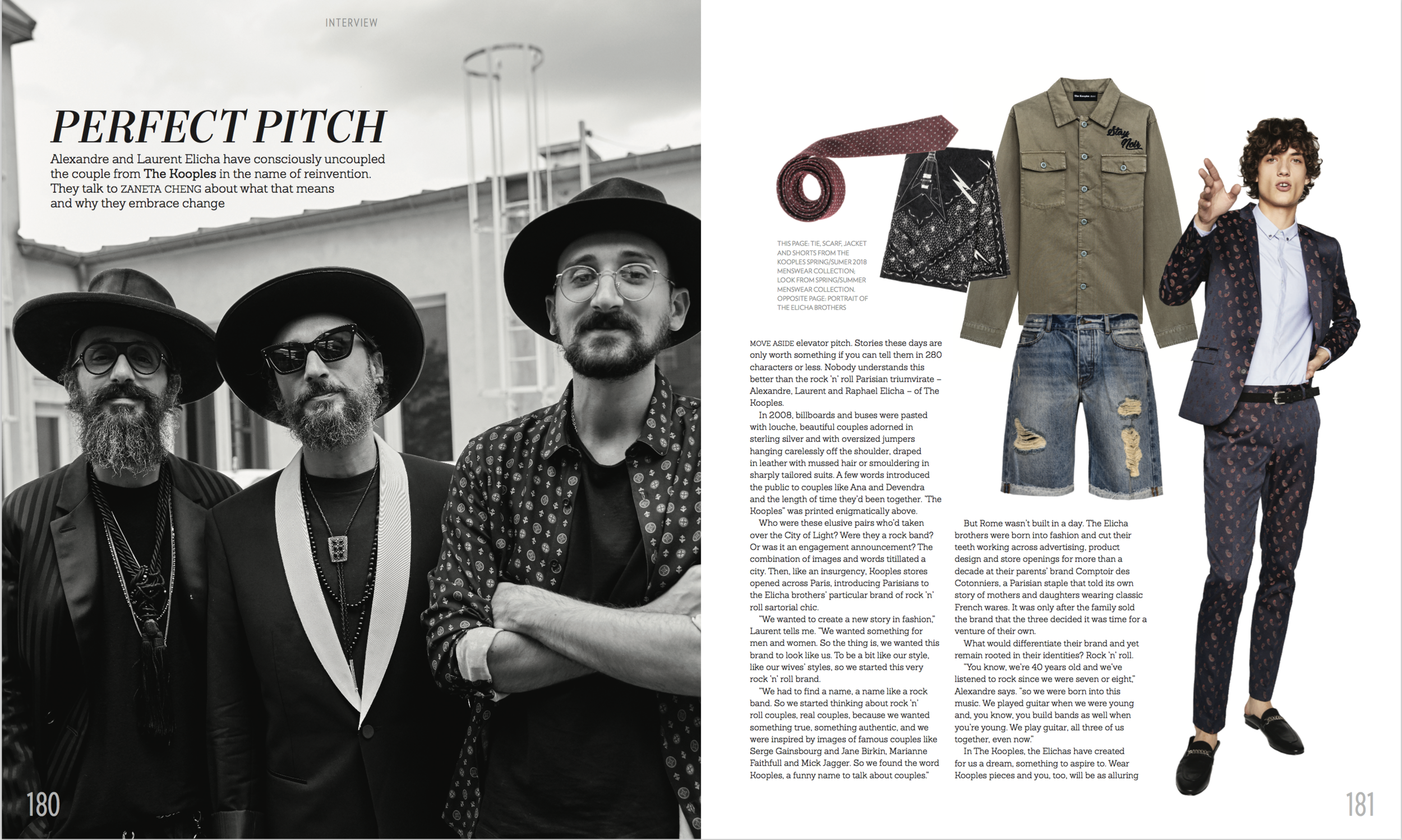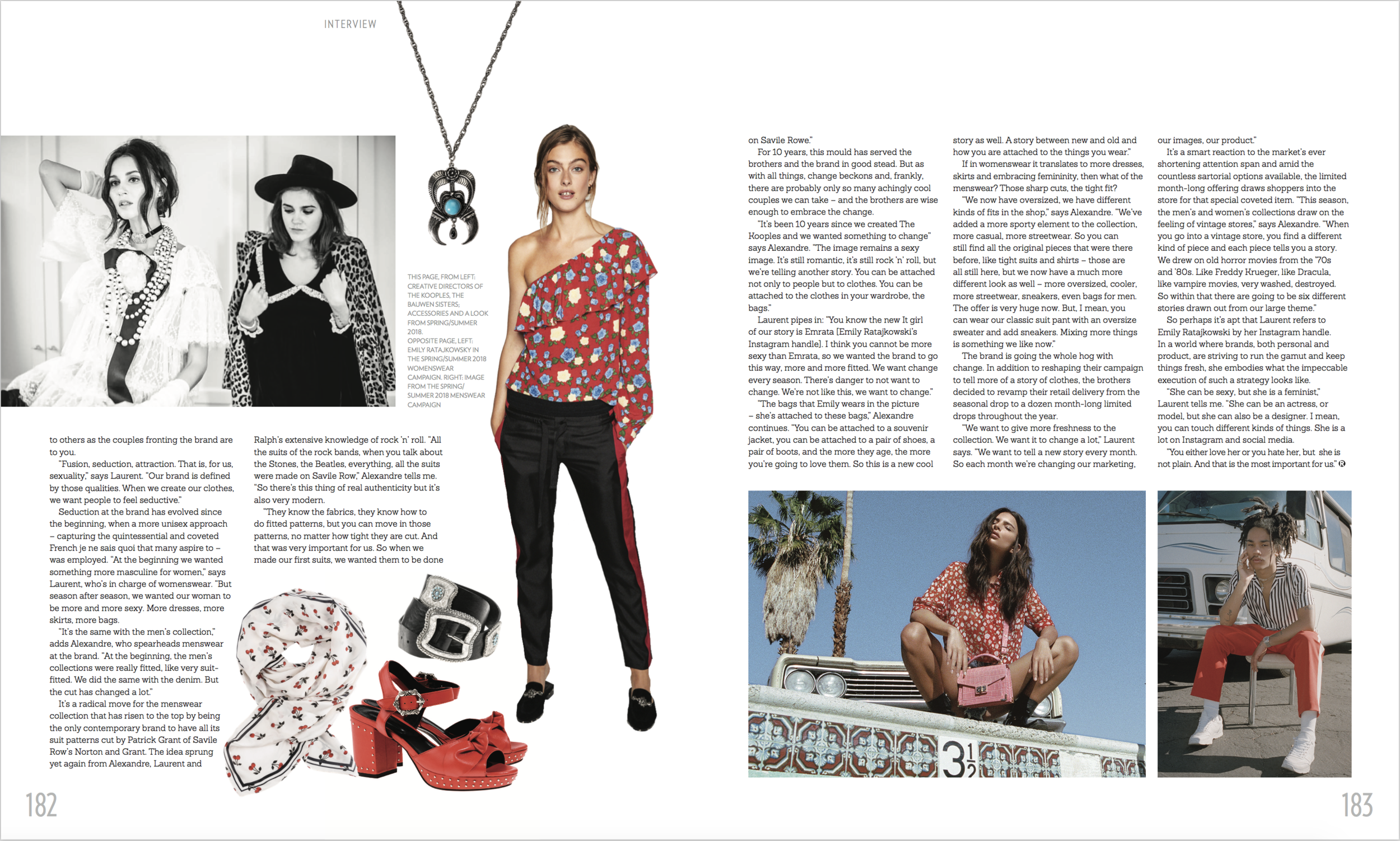The Kooples (Elicha Brothers) | Prestige Hong Kong (Apr 18)
Alexandre and Laurent Elicha have consciously uncoupled the couple from The Kooples in the name of reinvention. They talk to zaneta cheng about what that means and why they embrace change
Move aside elevator pitch. Stories these days are only worth something if you can tell them in 280 characters or less. Nobody understands this better than the rock ’n’ roll Parisian triumvirate – Alexandre, Laurent and Raphael Elicha – of The Kooples.
In 2008, billboards and buses were pasted with louche, beautiful couples adorned in sterling silver and with oversized jumpers hanging carelessly off the shoulder, draped in leather with mussed hair or smouldering in sharply tailored suits. A few words introduced the public to couples like Ana and Devendra and the length of time they’d been together. ‘The Kooples” was printed enigmatically above.
Who were these elusive pairs who’d taken over the City of Light? Were they a rock band? Or was it an engagement announcement? The combination of images and words titillated a city. Then, like an insurgency, Kooples stores opened across Paris, introducing Parisians to the Elicha brothers’ particular brand of rock ’n’ roll sartorial chic.
“We wanted to create a new story in fashion,” Laurent tells me. “We wanted something for men and women. So the thing is, we wanted this brand to look like us. To be a bit like our style, like our wives’ styles, so we started this very rock ’n’ roll brand.
“We had to find a name, a name like a rock band. So we started thinking about rock ’n’ roll couples, real couples, because we wanted something true, something authentic, and we were inspired by images of famous couples like Serge Gainsbourg and Jane Birkin, Marianne Faithfull and Mick Jagger. So we found the word Kooples, a funny name to talk about couples.”
But Rome wasn’t built in a day. The Elicha brothers were born into fashion and cut their teeth working across advertising, product design and store openings for more than a decade at their parents’ brand Comptoir des Cotonniers, a Parisian staple that told its own story of mothers and daughters wearing classic French wares. It was only after the family sold the brand that the three decided it was time for a venture of their own.
What would differentiate their brand and yet remain rooted in their identities? Rock ’n’ roll.
“You know, we’re 40 years old and we’ve listened to rock since we were seven or eight,” Alexandre says. “so we were born into this music. We played guitar when we were young and, you know, you build bands as well when you’re young. We play guitar, all three of us together, even now.”
In The Kooples, the Elichas have created for us a dream, something to aspire to. Wear Kooples pieces and you, too, will be as alluring to others as the couples fronting the brand are to you.
“Fusion, seduction, attraction. That is, for us, sexuality,” says Laurent. “Our brand is defined by those qualities. When we create our clothes, we want people to feel seductive.”
Seduction at the brand has evolved since the beginning, when a more unisex approach – capturing the quintessential and coveted French je ne sais quoi that many aspire to – was employed. “At the beginning we wanted something more masculine for women,” says Laurent, who’s in charge of womenswear. “But season after season, we wanted our woman to be more and more sexy. More dresses, more skirts, more bags.
“It’s the same with the men’s collection,” adds Alexandre, who spearheads menswear at the brand. “At the beginning, the men’s collections were really fitted, like very suit-fitted. We did the same with the denim. But the cut has changed a lot.”
It’s a radical move for the menswear collection that has risen to the top by being the only contemporary brand to have all its suit patterns cut by Patrick Grant of Savile Row’s Norton and Grant. The idea sprung yet again from Alexandre, Laurent and Ralph’s extensive knowledge of rock ’n’ roll. “All the suits of the rock bands, when you talk about the Stones, the Beatles, everything, all the suits were made on Savile Row,” Alexandre tells me. “So there’s this thing of real authenticity but it’s also very modern.
“They know the fabrics, they know how to do fitted patterns, but you can move in those patterns, no matter how tight they are cut. And that was very important for us. So when we made our first suits, we wanted them to be done on Savile Rowe.”
For 10 years, this mould has served the brothers and the brand in good stead. But as with all things, change beckons and, frankly, there are probably only so many achingly cool couples we can take – and the brothers are wise enough to embrace the change.
“It’s been 10 years since we created The Kooples and we wanted something to change” says Alexandre. “The image remains a sexy image. It’s still romantic, it’s still rock ’n’ roll, but we’re telling another story. You can be attached not only to people but to clothes. You can be attached to the clothes in your wardrobe, the bags.”
Laurent pipes in: “You know the new It girl of our story is Emrata [Emily Ratajkowski’s Instagram handle]. I think you cannot be more sexy than Emrata, so we wanted the brand to go this way, more and more fitted. We want change every season. There’s danger to not want to change. We’re not like this, we want to change.”
“The bags that Emily wears in the picture – she’s attached to these bags,” Alexandre continues. “You can be attached to a souvenir jacket, you can be attached to a pair of shoes, a pair of boots, and the more they age, the more you’re going to love them. So this is a new cool story as well. A story between new and old and how you are attached to the things you wear.”
If in womenswear it translates to more dresses, skirts and embracing femininity, then what of the menswear? Those sharp cuts, the tight fit?
“We now have oversized, we have different kinds of fits in the shop,” says Alexandre. “We’ve added a more sporty element to the collection, more casual, more streetwear. So you can still find all the original pieces that were there before, like tight suits and shirts – those are all still here, but we now have a much more different look as well – more oversized, cooler, more streetwear, sneakers, even bags for men. The offer is very huge now. But, I mean, you can wear our classic suit pant with an oversize sweater and add sneakers. Mixing more things is something we like now.”
The brand is going the whole hog with change. In addition to reshaping their campaign to tell more of a story of clothes, the brothers decided to revamp their retail delivery from the seasonal drop to a dozen month-long limited drops throughout the year.
“We want to give more freshness to the collection. We want it to change a lot,” Laurent says. “We want to tell a new story every month. So each month we’re changing our marketing, our images, our product.”
It’s a smart reaction to the market’s ever shortening attention span and amid the countless sartorial options available, the limited month-long offering draws shoppers into the store for that special coveted item. “This season, the men’s and women’s collections draw on the feeling of vintage stores,” says Alexandre. “When you go into a vintage store, you find a different kind of piece and each piece tells you a story. We drew on old horror movies from the ’70s and ’80s. Like Freddy Krueger, like Dracula, like vampire movies, very washed, destroyed. So within that there are going to be six different stories drawn out from our large theme.”
So perhaps it’s apt that Laurent refers to Emily Ratajkowski by her Instagram handle. In a world where brands, both personal and product, are striving to run the gamut and keep things fresh, she embodies what the impeccable execution of such a strategy looks like.
“She can be sexy, but she is a feminist,” Laurent tells me. “She can be an actress, or model, but she can also be a designer. I mean, you can touch different kinds of things. She is a lot on Instagram and social media.
“You either love her or you hate her, but she is not plain. And that is the most important for us.”

